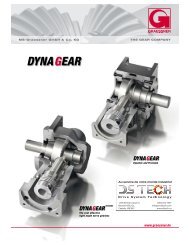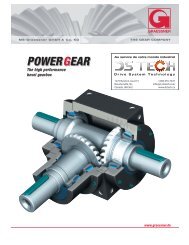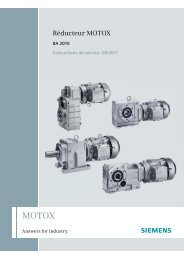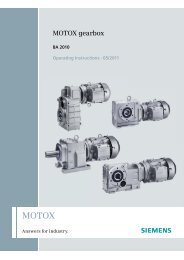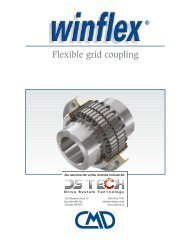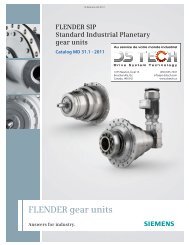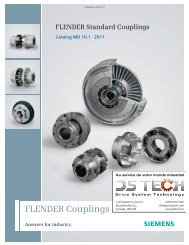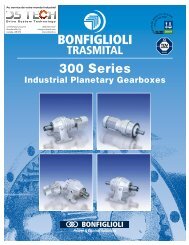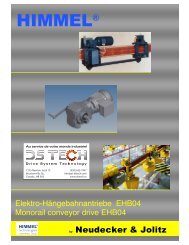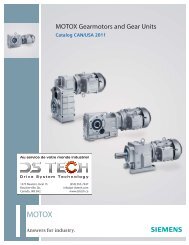You also want an ePaper? Increase the reach of your titles
YUMPU automatically turns print PDFs into web optimized ePapers that Google loves.
®<br />
Schneckenradsätze Worm and Wheel Sets Couples avec vis sans fin<br />
Charakteristische Vorzüge Characteristic Features Caractéristiques<br />
Prinzip der Verzahnung Principle of the Gear Teeth System Principe de la denture<br />
Die Hohlflanken-Zylinderschnecke mit ihrem globoidischen<br />
Schneckenrad weist gegenüber den<br />
üblichen Ausführungen einen wesentlichen Unterschied<br />
auf.<br />
Die Schneckenzähne haben konkaves Flankenprofil<br />
(Hohlflankenschnecke) anstelle eines geraden<br />
oder konvexen. Dadurch ergeben sich besondere<br />
Vorzüge, die des leichteren Verständnisses<br />
wegen stark vereinfacht dargestellt und erläutert<br />
sind.<br />
Bei der Hohlflanken-Verzahnung tritt eine geringe<br />
spezifische Flankenpressung (Hertz’sche Pressung)<br />
auf, und die Aufrechterhaltung eines trennenden<br />
Ölfilms zwischen den Zahnflanken wird<br />
besonders begünstigt, weil sich Hohlflanken mit<br />
balligen Gegenflanken berühren. Die Flankenschmiegung<br />
ist also sehr viel günstiger als bei<br />
sonst üblichen Verzahnungen, bei denen ballige<br />
Zahnflanken mit balligen Gegenflanken zum Eingriff<br />
kommen.<br />
In Bild 5.1 ist der entsprechende Fall für die Gleitlagerung<br />
einer Welle dargestellt, woraus deutlich<br />
wird, daß sich die bessere Flankenschmiegung<br />
auch bei der Hohlflanken-Verzahnung sehr vorteilhaft<br />
auswirken muß.<br />
Bei der Hohlflanken-Verzahnung ergibt ich eine<br />
besonders günstige Lage der Berührungslinien,<br />
die größtenteils rechtwin<strong>kl</strong>ig zur Gleitrichtung liegen.<br />
Hierdurch wird die Schmierdruckbildung,<br />
also die Erzeugung eines Ölfilms zwischen den<br />
Flanken, gefördert, während bei sonst üblichen<br />
Verzahnungen die Schmierdruckbildung geringer<br />
ist, da die Gleitrichtung überwiegend mit den Berührungslinien<br />
parallel liegt. Bild 5.2 zeigt wiederum<br />
die entsprechenden, hier übertrieben dargestellten<br />
Verhältnisse bei einer Gleitlagerung.<br />
Es wird deutlich, daß bei Drehung der Welle –<br />
Gleitrichtung genau rechtwin<strong>kl</strong>ig zur Berührungslinie<br />
– die Schmierdruckbildung am besten ist,<br />
während bei Bewegung der Welle in Achsrichtung<br />
– Gleitrichtung genau parallel zur Berührungslinie<br />
– kein Schmierdruck aufgebaut wird.<br />
Bei der Hohlflanken-Verzahnung wird durch die<br />
Schneckenzahnform und die Lage der Wälzlinie<br />
eine besonders große Zahnfußdicke S 2 am<br />
Schneckenrad erreicht (Bild 5.3), ohne dabei den<br />
Schneckenzahn zu schwächen.<br />
The concave-profile cylindrical worm with its<br />
enveloping worm wheel is substantially different<br />
to conventional designs.<br />
The worm threads have a concave profile instead<br />
of an involute or convex one. The illustrations and<br />
explanations in the following show in a very<br />
simplified form the operating advantages this<br />
profile provides.<br />
The concave-profile teeth are subject to only low<br />
specific tooth pressure (Hertzian pressure) and<br />
the maintenance of an oil film between the tooth<br />
flanks is particularly assisted, because the concave<br />
threads are in contact with convex gear<br />
teeth. The profile contact is therefore much more<br />
favourable than in conventional gear teeth<br />
systems in which convex teeth are in contact with<br />
convex mating tooth flanks.<br />
Fig 5.1 shows an example of a shaft running in<br />
journal bearings to indicate that improved profile<br />
contact must also have a very favourable effect<br />
on the concave-profile teeth.<br />
The concave-profile teeth provide a particularly<br />
favourable position of the instantaneous axes<br />
which extend mainly at right angles to the sliding<br />
direction. Thus, the build-up of lubricating pressure,<br />
i.e. the generation of an oil film between the<br />
tooth flanks is assisted, while in conventional gear<br />
teeth systems the lubricating pressure build-up is<br />
lower since the sliding direction is mainly<br />
parallel to the instantaneous axes. Fig 5.2 shows<br />
the corresponding conditions (in this case shown<br />
in exaggerated form) obtained with journal<br />
bearings. It is clearly visible that the best lubricating<br />
pressure exists when the shaft rotates –<br />
sliding direction precisely at right angles to the<br />
instantaneous axes – while no lubricating pressure<br />
is generated by movement of the shaft in the<br />
axial direction – sliding direction parallel to the<br />
instantaneous axes.<br />
Owing to the worm thread shape and the position<br />
of the pitch circle in concave-profile gear teeth<br />
systems a particularly large tooth root thickness<br />
S 2 on the worm wheel is obtained (Fig. 5.3)<br />
without, however, weakening the worm thread.<br />
La vis sans fin à flancs concaves, avec sa roue<br />
dentée globulaire, présente une différence fondamentale<br />
par rapport aux dentures courantes.<br />
Les dents de la vis ont des flancs à profil concave<br />
(vis à flancs creux) au lieu d’un profil droit ou convexe.<br />
Il en résulte des avantages caractéristiques<br />
que nous avons pour en faciliter la compréhension,<br />
représentés ci-après de façon très simplifiée<br />
et que nous expliquons ci-dessous.<br />
Du fait de la forme concave de la denture, la pression<br />
spécifique entre les flancs (pression de<br />
Hertz) est moindre. L’engrènement des flancs<br />
concaves de la vis avec les flancs convexes de la<br />
roue facilite considérablement le maintien d’un<br />
film d’huile entre les dentures. L’engrènement<br />
des dents se fait beaucoup mieux que dans les<br />
dentures ordinaires où les flancs convexes de la<br />
vis doivent entrer en prise avec les flancs convexes<br />
de la roue.<br />
On a représenté à la fig. 5.1 un cas similaire: un<br />
arbre supporté par un coussinet lisse. On constate<br />
aisément une amélioration du contact qui se<br />
retrouve aussi dans le système de denture concave.<br />
Dans celui-ci, la position des lignes de contact est<br />
particulièrement avantageuse. Elles sont, pour la<br />
plupart, perpendiculaires au sens du glissement.<br />
Ceci favorise la formation d’un “coin d’huile”<br />
créant un film d’huile sous pression entre le dents.<br />
Dans les dentures courantes, le film d’huile s’établit<br />
plus difficilement du fait que la plupart des lignes<br />
de contact sont parallèles au sens du glissement.<br />
On a encore représenté à la fig. 5.2, de<br />
façon exagérée, les conditions semblables d’un<br />
arbre à palier lisse. On voit bien que si l’arbre<br />
tourne (déplacement perpendiculaire aux lignes<br />
de contact) la formation du film d’huile est la meilleure,<br />
tandis que, si l’arbre se déplace dans le<br />
sens axial (déplacement parallèle aux lignes de<br />
contact) le film d’huile ne peut se former.<br />
Dans les dentures de la vis à flancs concaves, les<br />
formes des dents de la vis et la position de la ligne<br />
d’engrènement permettent d’obtenir une dent de<br />
roue à la base particulièrement large (fig. 5.3)<br />
sans que pour cela la dent de la vis s’en trouve affaiblie.<br />
1.5giF / dliB<br />
XEVAC<br />
konventioneller<br />
Schneckentrieb<br />
Conventional worm<br />
gearing<br />
Engrenage à vis<br />
sans fin ordinaire<br />
2.5giF / dliB<br />
XEVAC<br />
konventioneller<br />
Schneckentrieb<br />
Conventional worm<br />
gearing<br />
Engrenage à vis<br />
sans fin ordinaire<br />
CAVEX<br />
3.5giF / dliB<br />
konventioneller<br />
Schneckentrieb<br />
Conventional worm<br />
gearing<br />
Engrenage à vis<br />
sans fin ordinaire<br />
K882 DE/EN/FR<br />
(450) 655-7447<br />
info@pt-dstech.com<br />
www.dstech.ca<br />
1275 Newton, local 15<br />
Boucherville, Qc,<br />
Canada, J4B 5H2<br />
5



